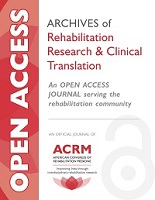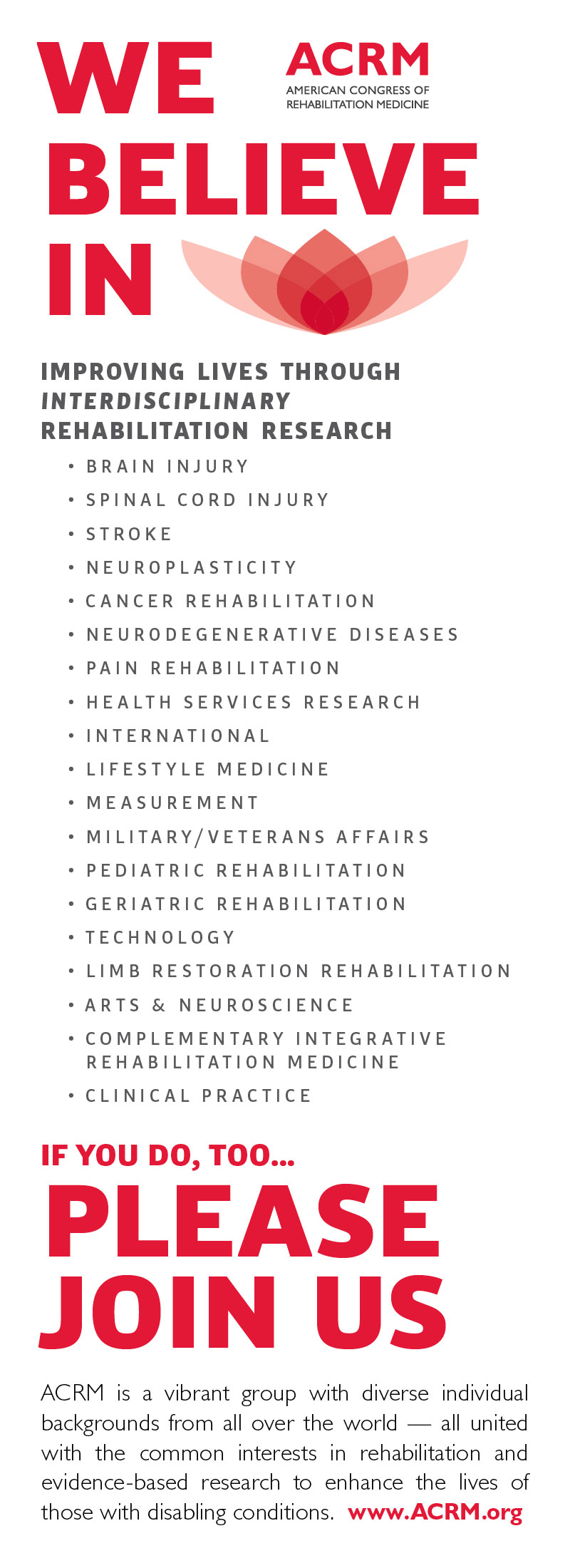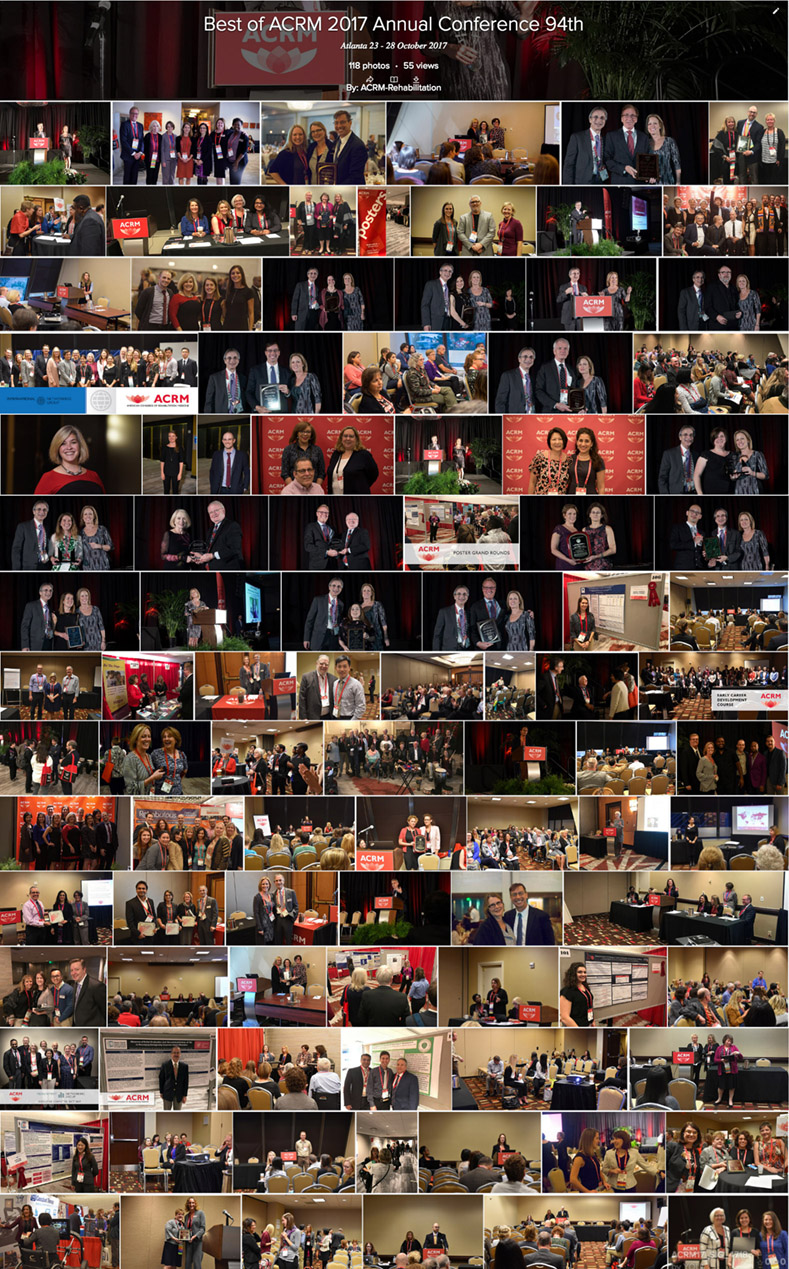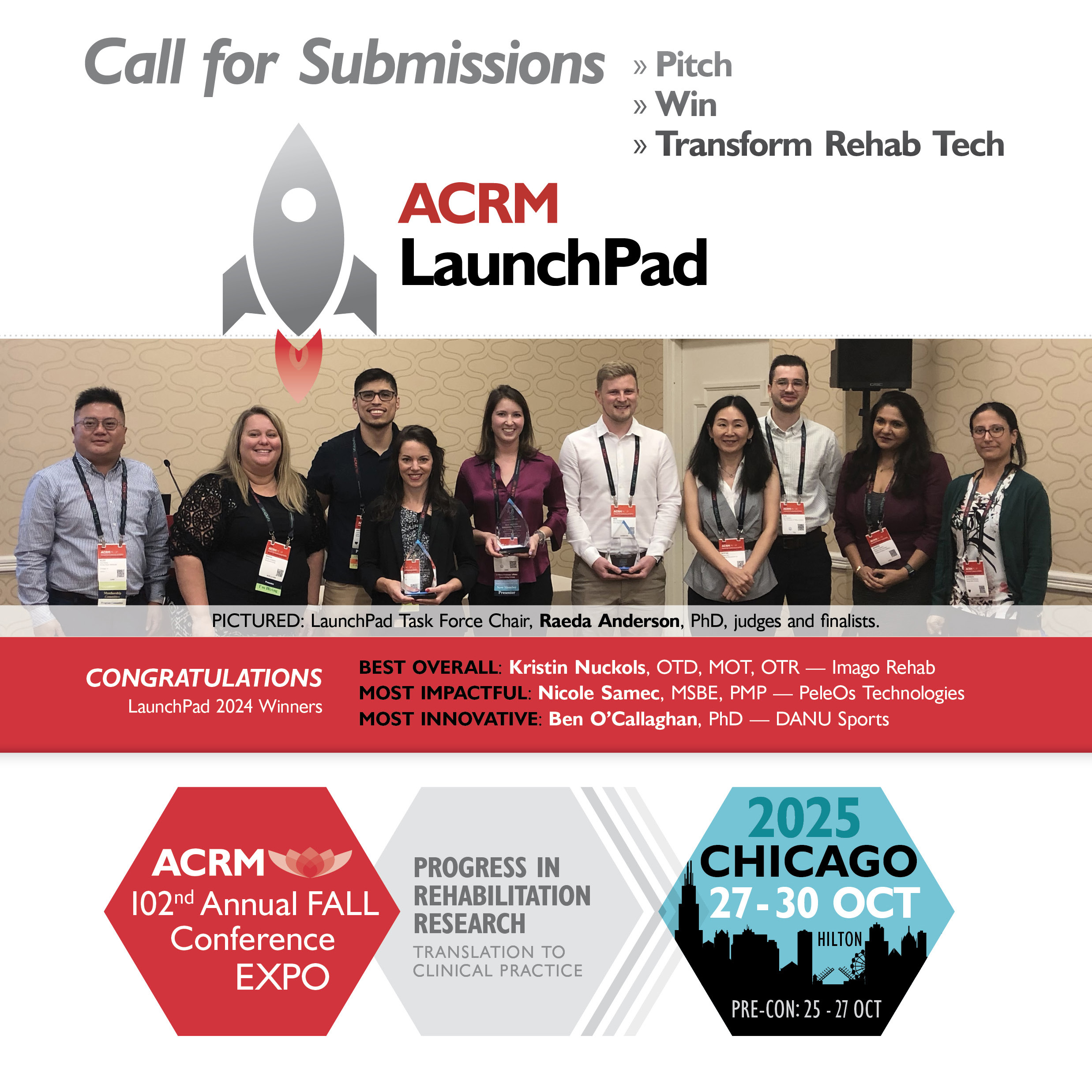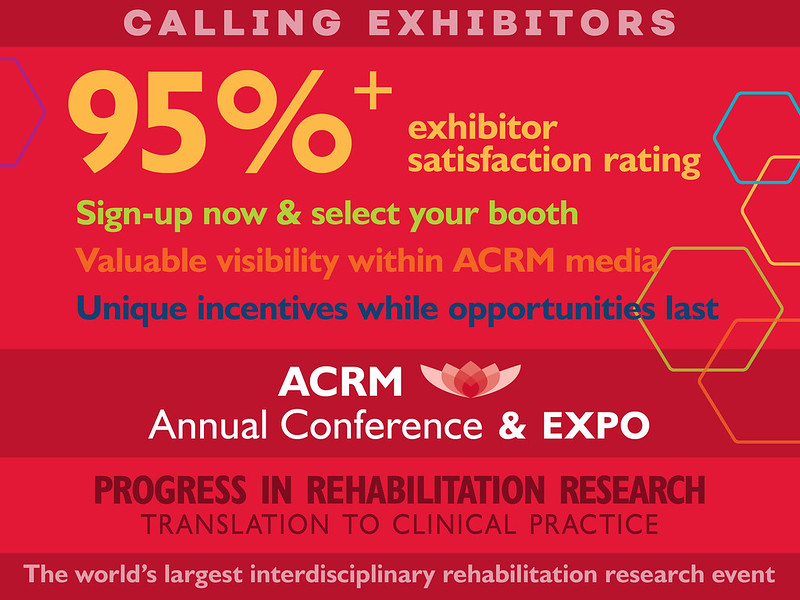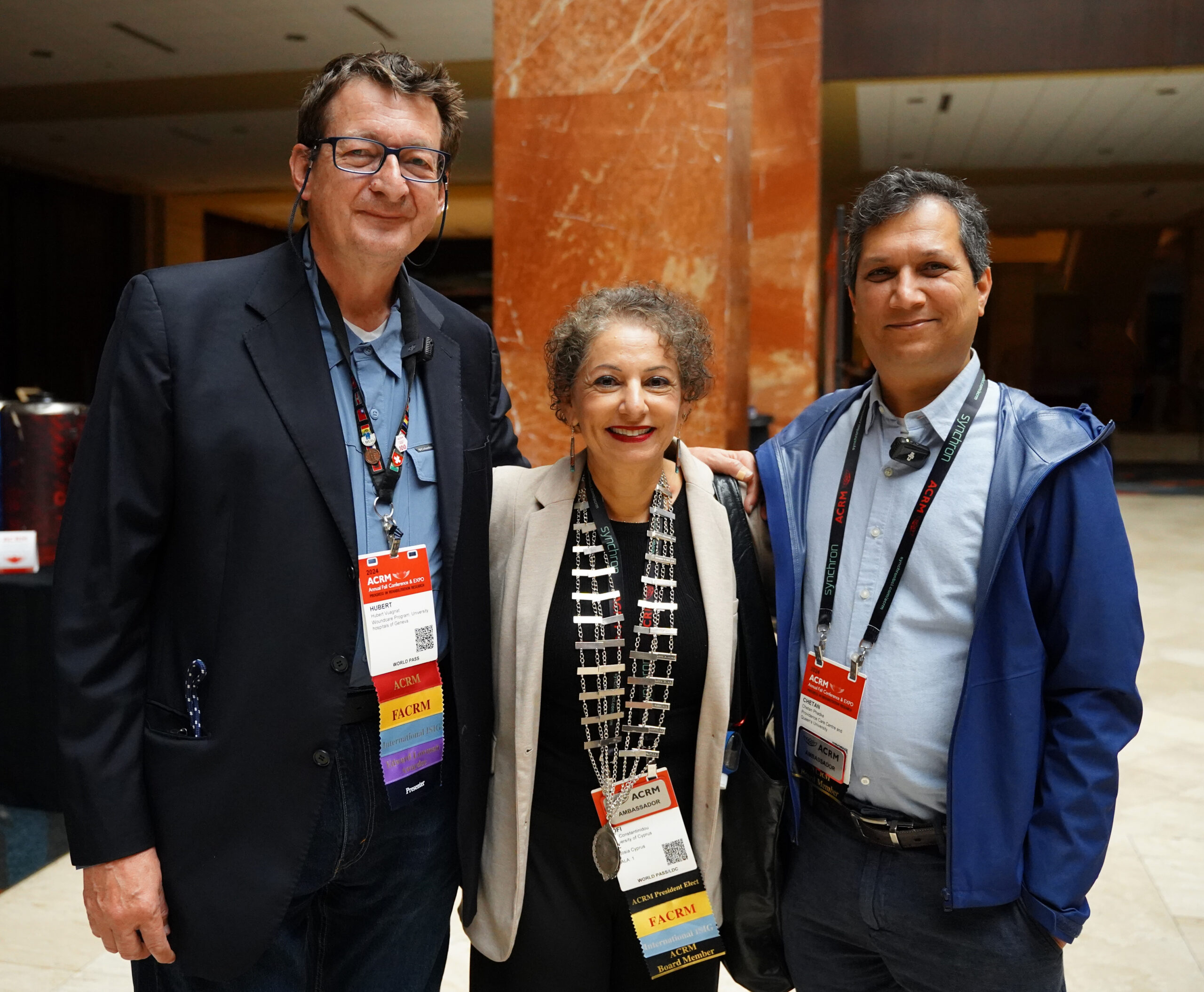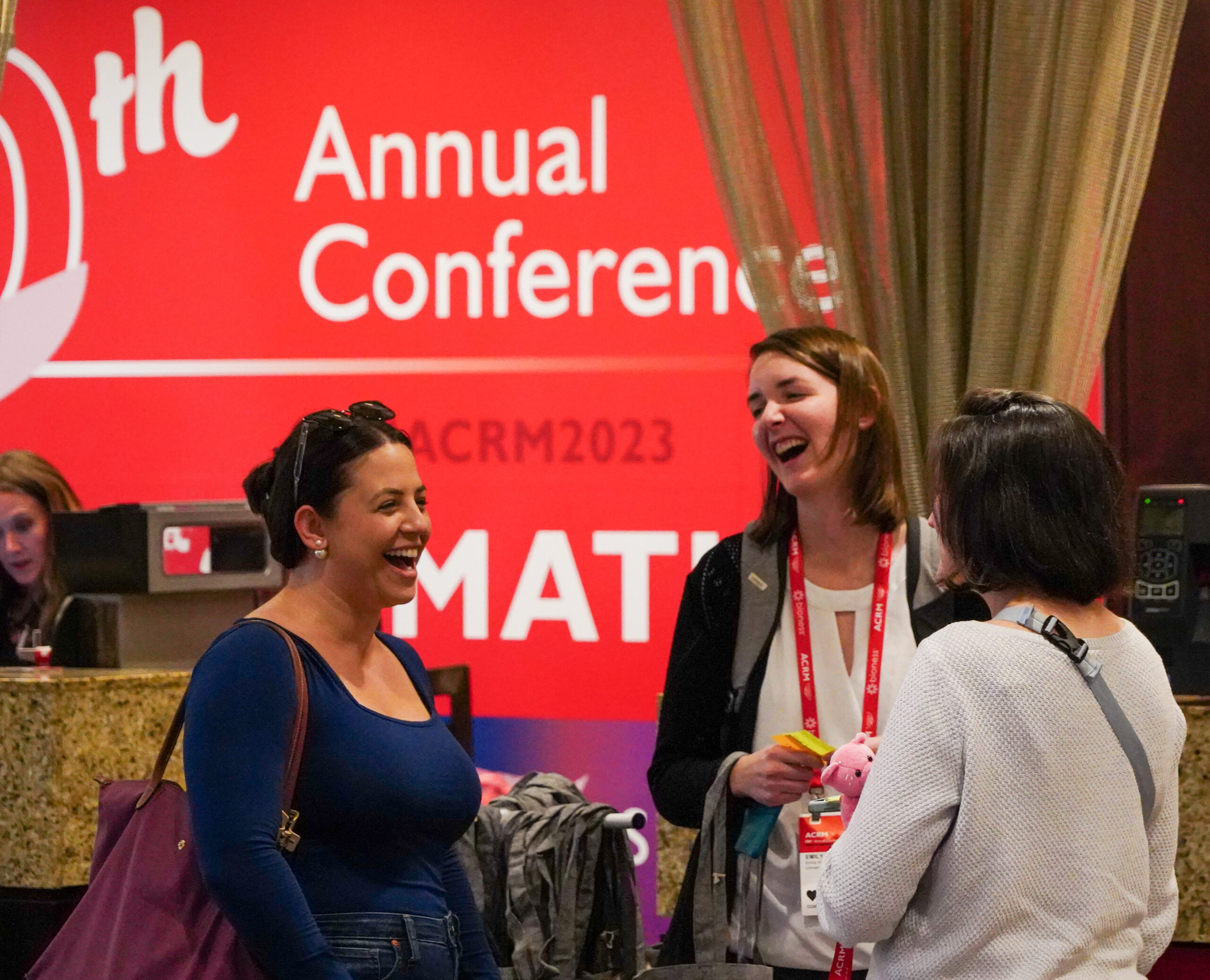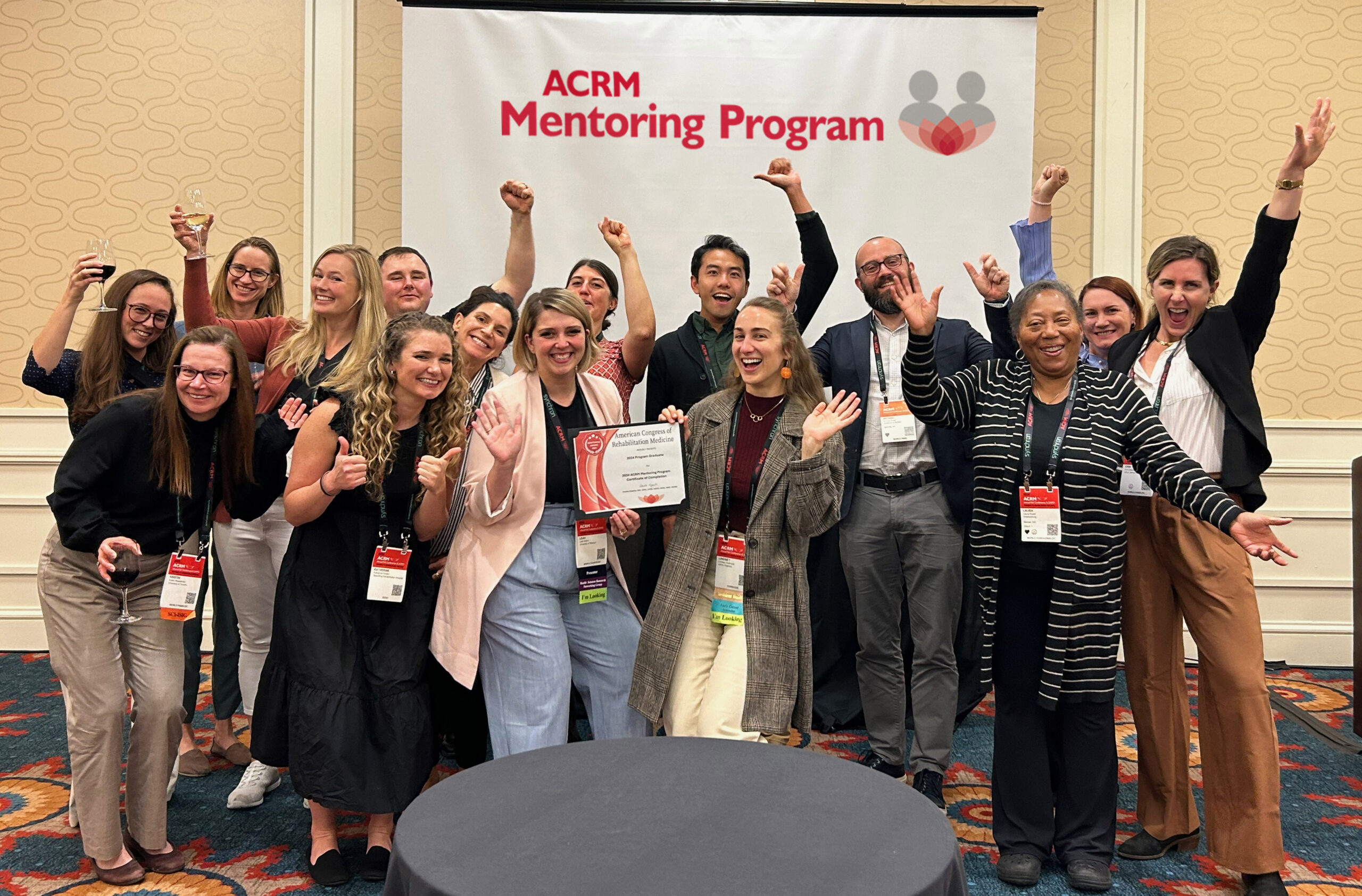Who is ACRM?
ACRM | American Congress of Rehabilitation Medicine
ACRM stats & facts:
- We are a non-profit medical association with a mission to IMPROVE the LIVES of disabled people
- ACRM has a 100+ year history
- We work with hospitals, universities, professional and advocacy organizations, and rehabilitation professionals GLOBALLY
- We are the fastest-growing professional association in physical medicine and rehabilitation
- We have 100,000+ members from more than 65 countries
- We have 25+ special-interest and networking groups and steadily growing
- We are interprofessional
- We promote evidence-based practice and practice-based research
- We are inclusive
- We embrace diverse opinions and thoughts in order to get the science into practice FASTER
ACRM JOURNALS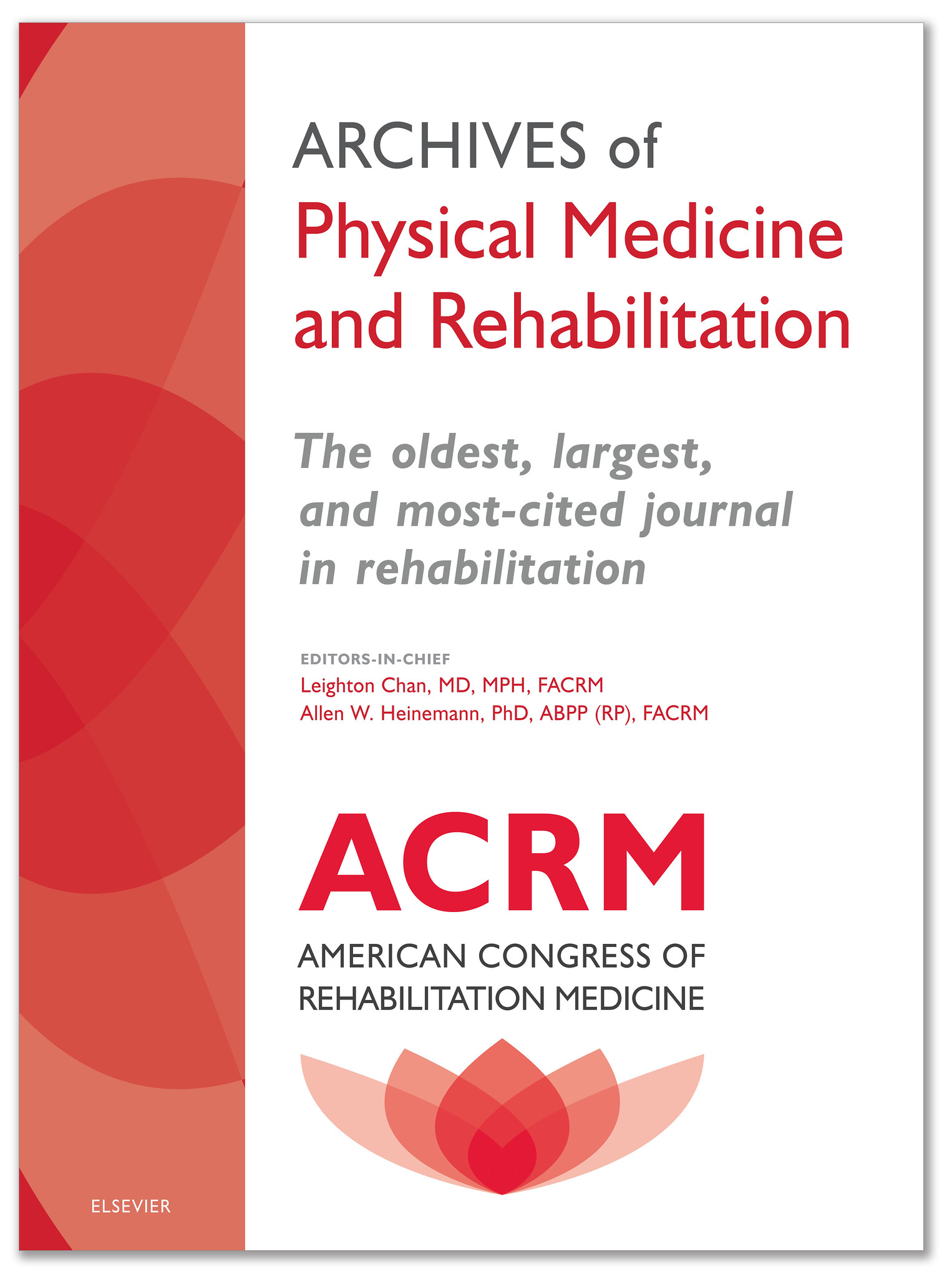
ABOUT The Archives of Physical Medicine & Rehabilitation
-
- The ACRM journal, Archives of Physical Medicine & Rehabilitation, is the MOST-CITED JOURNAL IN REHABILITATION
- ACRM has the highest-rated rehabilitation medicine journal in the world:
- With 25,000+ lifetime citations, ARCHIVES is by far the most cited of all PM&R journals.
- Impact Factor of 3.6 (2023) <<< the highest of all general rehabilitation journals that are not discipline- or condition-specific
- CiteScore of 6.2 (2023) – ALL TIME HIGH
- Have you seen the ARCHIVES lately? >>
ABOUT The Archives of Rehabilitation Research & Clinical Translation
-
- ARRCT has a 2023 Impact Factor of 1.9 and a 2023 CiteScore of 3.0
- ARRCT is indexed in PubMed Central and the Directory of Open Access Journals (DOAJ).
- Learn more >>
The ACRM Annual Fall Conference OVERVIEW
Translation Limitation Policy
ACRM is an organization that operates using US English as its official and only language. ACRM has looked at language translation options carefully. However, due to potential legal and medical liability issues, ACRM is unable to provide translations to other languages.
THE ACRM CULTURE
- ACRM is welcoming
- Networking is ubiquitous
- ACRM places a priority on nurturing the research careers of early-career professionals
- Members are passionate for the research, for IMPROVING LIVES, including their own
- Serious about mentoring, about the science, and about having FUN
- ACRM welcomes ALL — PM&R professionals, consumers and caregivers
- NO MATTER where you come from, who you are, or what your title is — YOU ARE WELCOME here
- At ACRM events, prominent professionals in the field of PM&R, including presenters are available and they WANT to meet with you
- Collaboration over competition
If you believe in these attributes, you will love ACRM. And ACRM will love you.
Won’t you please join our mailing list here>>
Physical address: 11654 Plaza America Drive, Suite 535 Reston, VA 20190 Telephone: +1.703.435.5335 General email: info@acrm.org
Building the Next Generation of Rehabilitation Researchers
- Researchers and scientists
- Physicians, clinicians and nurses
- Counselors and therapists
- Case managers and administrators
- Biomedical engineers and others
Leadership Role
As rehabilitation science evolves, ACRM’s goal is to keep the community connected by creating opportunities to exchange and share information among clinical practitioners, rehabilitation researchers, knowledge brokers, research funders, provider organizations, healthcare payers, and industry regulators.
ACRM encourages leaders in rehabilitation to identify current best practices and best providers at all levels of care, and share this information via education meetings and the journal, Archives of Physical Medicine and Rehabilitation.
ACRM aims to support multidisciplinary leadership and practice innovation to ensure that people living with chronic disease or disability have access to effective rehabilitation services throughout their lives.
ACRM serves as a forum for creating and discussing new treatment paradigms that take into account the composition of the rehabilitation team, the duration of care, and the venues required to achieve optimal functional outcomes for people with chronic disease and disabilities.
ACRM is dedicated to serving as an advocate for public policy and legislative issues that support individuals with disabilities and providers of rehabilitation services; helping develop innovative and cost-effective models of collaborative care and comprehensive rehabilitation management; leading research efforts that examine and develop the most effective clinical technology and treatment paradigms; and initiating dialogue with payers and regulators to communicate the collaborative care models that produce positive rehabilitation outcomes.
Organization
ACRM is led by elected members organized into the Board of Governors. Supporting the Board of Governors are volunteer standing committees as well as a business team led by the Chief Executive Officer.
BOARD OF GOVERNORS>>
Special Interest & Networking Groups
The life-blood of ACRM is comprised of dozens of member-led interdisciplinary special interest and networking groups, and committees:
Interdisciplinary Special Interest Groups
- Brain Injury Interdisciplinary Special Interest Group (BI-ISIG)
- International Interdisciplinary Special Interest Group (I-ISIG)
- Measurement Interdisciplinary Special Interest Group (M-ISIG)
- Spinal Cord Injury Interdisciplinary Special Interest Group (SCI-ISIG)
- Stroke Interdisciplinary Special Interest Group (STROKE-ISIG)
Networking Groups
- Aging Research & Geriatric Rehabilitation Networking Group (ARGR-NG)
- Arts & Neuroscience Networking Group (AN-NG)
- Behavioral Health Networking Group (BH-NG)
- Cancer Rehabilitation Networking Group (CR-NG)
- Career Development Networking Group (CD-NG)
- Complementary, Integrative Rehabilitation Medicine Networking Group (CIRM-NG)
- Early Career Networking Group
- Geriatric Rehabilitation Networking Group
- Health Services Research Networking Group (HSR-NG)
- Lifestyle Medicine Networking Group (LM-NG)
- Limb Care Networking Group (LC-NG)
- Military / Veterans Affairs Networking Group (MVA-NG)
- Neurodegenerative Diseases Networking Group (ND-NG)
- Neuroplasticity Networking Group (N-NG)
- Pain Rehabilitation Networking Group
- Pediatric Rehabilitation Networking Group (PR-NG)
- Physicians & Clinicians Networking Group (PC-NG)
- Rehabilitation Treatment Specification Networking Group (RTS-NG)
- Technology Networking Group (T-NG)
NEW / FORMING GROUPS
ACRM Burn Rehabilitation Networking Group
Membership
ACRM welcomes as members all stakeholders in rehabilitation, including physicians, clinicians, researchers, administrators, consultants, consumers, educators, research funders, insurers, and policymakers.
Members meet colleagues from around the world, engage with experts and mentors, learn new research strategies, access the latest clinical guidelines, advance academic and research careers, and gain opportunities to shape and lead the field of rehabilitation. Members represent various disciplines, including:
- Academia
- Administration
- Audiology
- Biomedical Engineering
- Biostatistics
- Case Management
- Clinical Epidemiology
- Counseling, Rehabilitation
- Counseling, Vocational
- Dietetics | Nutrition
- Health Services Research
- Neurology | Neurosurgery
- Neuropsychology
- Nursing
- Occupational Therapy
- Pediatrics
- Psychology
- Physiatry
- Physical Therapy
- Psychiatry
- Research
- Recreation Therapy
- Rehabilitation Medicine
- Rehabilitation Nursing
- Rehabilitation Psychology
- Social Work
- Speech | Language Pathology
Archives of Physical Medicine and Rehabilitation
Archives of Physical Medicine & Rehabilitation (ARCHIVES) is an acclaimed international journal covering the specialty of physical medicine and rehabilitation as well as interdisciplinary disciplines involved in rehabilitation. The numbers keep getting better so please see the ARCHIVES site for the latest: Ranked ninth of 63 journals in Rehabilitation, Archives boasts a 2012 Impact Factor of 2.358 and the highest Eigenfactor in the category, according to Thomson Reuters Journal Citation Report, Science Edition. ARCHIVES is the most cited journal in rehabilitation, logging 2.5 million downloads per year. Original articles report important trends and deliver authoritative information on the therapeutic utilization of physical behavioral and pharmaceutical agents in providing comprehensive care for individuals with chronic illness and disabilities. Annual subscriptions to ARCHIVES are FREE to ACRM members. Members also receive free online access to archival issues of Physical Medicine and Rehabilitation Clinics of North America published by Elsevier. Non-members may subscribe directly from the Archives website.
History see full history here
Content for this timeline was obtained from historical records, conference proceedings, and other documents of the ACRM. This is in no way intended to reflect the comprehensive history, and therefore, it is highly likely that many significant events are not included. It is a summary of those events and markers that reflect the evolution of ACRM.
1923: The Congress was founded as the American College of Radiology and Physiotherapy, a professional association of physicians who used physical agents, and particularly electricity and x-rays, to diagnose and treat illness and disability. The first president was Samuel B. Childs, MD.’
1925: The trend toward specialization in medicine resulted in a separation of radiology from physical therapy and a change in name to the American Congress of Physical Therapy.
1926: The Journal of Radiology, which began publication in 1920, changed its name to the Archives of Physical Therapy, X-ray, Radium and was declared the official journal of the American Congress of Physical Therapy.
1930: Albert F. Tyler, MD, the owner of the journal, presented the Archives to the Congress as a debt-free, unencumbered gift.
1932: The first Gold Key Awards were given to a total of seven people, including William L. Clark, F. Howard Humphris, and Albert F. Tyler.
1933: In a change reflecting the times, the American Congress of Physical Therapy assimilated the American Physical Therapy Association, and Albert F. Tyler, MD, was elected as president of the newly configured association.
1938: The journal name was shortened to Archives of Physical Therapy due to the decreased emphasis on X ray and radium.
1939: A specialty society was founded called the Society of Physical Therapy Physicians, which became the American Academy of Physical Medicine and Rehabilitation (AAPM&R) in 1956. The society was restricted to physicians who devoted themselves exclusively to the practice of physical therapy. The Archiveswas designated as its official journal.
1944: The Congress again changed names, to the American Congress of Physical Medicine.
1945: The 24th Annual Meeting was canceled at the request of the National War Committee on Conventions. This was the first and only time since the Congress was founded that an annual meeting was not held. The name of the journal became the Archives of Physical Medicine. The term “physical medicine” represented a change of emphasis from the purely clinical to the scientific and diagnostic basis of the medical use of physical agents. It also served to clarify the distinction between physicians and technicians of physical therapy, a stance the American Medical Association (AMA) had recently adopted.
1949: During the annual meeting the membership voted to collaborate with the British Association of Physical Medicine in the formation of an International Federation of Physical Medicine.
1951: The first John Stanley Coulter Memorial Lecture was presented by Kristian G. Hansson, MD, and highlighted the many contributions of John S. Coulter, MD, the third association president.
1952: Increasing recognition of the relationship between physical medicine and the rapidly growing field of rehabilitation resulted in a change in name to the American Congress of Physical Medicine and Rehabilitation.
1953: The official name of the journal changed to its present name, Archives of Physical Medicine and Rehabilitation.
1965: A thorough study of the Congress and its functions was begun with the formation of the Professional Development Committee (PDC) under the chairmanship of John W. Goldschmidt, MD. Notable accomplishments of the PDC included a study of the objectives, constitution, and structure of the Congress, sponsorship of interdisciplinary forums, and a broadening of the membership.
1966: A group of forward-looking physicians in the Congress recognized the need for a forum in which members of various rehabilitation disciplines could share their professional, scientific, and technical talents. An amendment to the Congress constitution extended membership privileges to persons “holding an earned doctoral degree and active in and contributing to the advancement of the field of rehabilitation medicine.” This allowed membership to be extended to psychologists, nurses, physical therapists, occupational therapists, speech pathologists, social workers, vocational counselors, and others. The name was officially changed once again, to the American Congress of Rehabilitation Medicine (ACRM).
1968: The first Interdisciplinary Forum was held, supported by a training grant from the Department of Health, Education and Welfare’s Rehabilitation Services Administration. Some of the topics included Stroke, Intellectual-Perceptual Deficits and Implications for Team Management, and Operant Conditioning.
1970: Another constitutional amendment opened the membership to rehabilitation professionals with earned Master’s degrees.
1972: The PDC published the landmark report “Development of the American Congress of Rehabilitation Medicine into a Multidisciplinary Professional Society”. As noted in the introduction of the report, “this report reviews the methodology by which reorganization [of the association] was accomplished and records the progress made in restructuring membership, program, publications, and governance.”
1973: ACRM formed the ad hoc Committee on Rehabilitation of Children to address the unique needs of this population. The committee was active for over a decade and included Dennis Mathews, Michael Alexander, Gabriella Molnar, Bruce Gans, and other noted pediatric physiatrists. One of the most notable achievements of this committee was the allotment of more time in ACRM meetings to pediatric issues.
1973: A major exhibition tracing the development of physical medicine in the United States in the past 200 years opened at the Smithsonian Institution in Washington, DC, under sponsorship of the ACRM. Entitled Triumph Over Disability, the exhibit was planned as part of the observance of the 50th anniversary of the founding of ACRM.
1975: ACRM’s Social and Environmental Aspects of Rehabilitation (SEAR) Committee was formed to work in collaboration with the Legislative Committee in making legislative recommendations and in developing model architectural barrier legislation. During the Carter administration, under the direction of Chair Nancy Crewe, PhD, SEAR was asked to examine some of the issues involved in independent living and to prepare a position paper that could be used in testimony. SEAR’s involvement in the independent living movement led to the 1978 Amendments of the Rehabilitation Acts of 1973.[1]
1976: The first prize in the scientific exhibit competition was awarded to the Sexuality and Disability exhibit presented by Sandra and Ted Cole. This exhibit led to the establishment of the Sexuality and Disability Task Force. The Task Force changed its name to the Sexuality Interdisciplinary Interest Group, which in turn led to the creation of ACRM’s first Special Interest Group (SIG). This was the genesis of today’s Interdisciplinary SIGs.
1977: The first non-physician ACRM president, June Rothberg, PhD RN, took office. In her presidential address entitled “…And It Came to Pass,” she focused on the evolution of ACRM from uni-dimensional to multi-professional in scope and interest.
1979: The first official meeting of the ACRM Head Injury Task Force, chaired by Sheldon Berrol, MD, took place at the annual meeting. Now known as the Brain Injury ISIG, this group has been very influential in the development of standards and guidelines in the brain injury rehabilitation field over the past 20 years.
1979: The article “Independent Living: From Social Movement to Analytic Paradigm” by Gerben DeJong, PhD,[2] was printed in the October issue of the Archives. This landmark article was reprinted sixteen times in various rehabilitation-related books and journals, and translated into seven languages.
1980: The first Elizabeth and Sidney Licht Award for Excellence in Scientific Writing was presented to Carl Granger, Gary Albrecht, and Byron Hamilton for their article “Outcomes of Comprehensive Medical Rehabilitation: Measurement by PULSES Profile and the Barthel Index”.[3]
1986: Rehabilitation professionals with Bachelor’s degrees were admitted into membership. In financial trouble, ACRM sells a half-ownership in Archives to AAPM&R for the “sum of $10 and other good and valuable considerations”. The sale agreement stipulates that the journal can only be sold to ACRM, for $1.
1989: The first Distinguished Member Award was presented to Mary Romano, MSW (posthumously). The first Edward W. Lowman Award was presented to Wilbert Fordyce, PhD.
1990: ACRM was prominently involved in support for the Americans with Disabilities Act,[4] which was signed into law on July 26, 1990. The ACRM separated operationally from the shared offices and management of the AAPM&R.
1991: At the annual meeting in Washington, DC, organizational politics focused on the changes resulting from the decision to separate from shared offices and management with AAPM&R. Revisions to the constitution and bylaws were debated during the annual business meeting. Substantive changes included a restructuring of the Board of Governors to eliminate the succession through multiple offices to the presidency. An executive committee was established and provisions requiring submission of an annual budget were included.
1993: The first independent annual meeting of ACRM was held in Denver, CO. This was the first meeting held independently from the AAPM&R since 1938.
1995: Continuing with the transition of the organizational structure, a total of six members-at-large were seated on the Board of Governors. Thomas P. Dixon, PhD, who was the last individual to be elected as fifth vice president, ascended to the presidency. Under Dixon’s direction, the corporate membership program began to expand substantially.
1996: The Board of Governors began articulating a new vision for ACRM. This new vision was developed in response to the changing dynamics within healthcare and changing demographics within the membership of ACRM, specifically the loss of many physician members who previously had belonged to both ACRM and the AAPM&R.
1997: Continuing the evolution, the Board of Governors conducted an extensive study of the field of medical rehabilitation associations and professionals to determine the need and focus for ACRM in the future. Based on the findings and the coincidental release of the Institute of Medicine Report, Enabling America, the Board committed to an organizational focus devoted exclusively to rehabilitation research, as a home for those who generate, utilize, or fund rehabilitation research.
1998: Theodore M. Cole, MD is the second to serve two terms as president of ACRM (1993 and 1998). Evidence of the changing focus on relevant rehabilitation research is reflected in articles published in the ACRM newsletter, Rehabilitation Outlook, and in the content of the annual educational conference. ACRM celebrates its 75th Anniversary during the annual meeting held in Seattle, WA, November 8–10, 1998.
2000: President, Steven Hinderer, MDThe ACRM struggled to survive because of the recent separation from joint meetings with the AAPM&R. Membership was declining and the board of governors voted to hire the management of the AAP to provide more direct and committed day to day support of the organization, which helped to stabilize the finances and conduct autonomous annual meetings. Ric Morgan became executive director at this time.
The ACRM struggled to survive because of the recent separation from joint meetings with the AAPM&R. Membership was declining and the board of governors voted to hire the management of the AAP to provide more direct and committed day to day support of the organization, which helped to stabilize the finances and conduct autonomous annual meetings. Ric Morgan became executive director at this time.
2001 – 2002: President, Martin Grabois, MD, FACRMThe years 2000-2002 were a challenge for the organization’s finances and leadership. We had separated from the AAPM&R, separated from AAP management, and set up a joint meeting with the American Society of Neurorehabilitation. With the help of the board of governors and our membership, we righted the ship, setting up a period of growth for the ACRM.
The years 2000-2002 were a challenge for the organization’s finances and leadership. We had separated from the AAPM&R, separated from AAP management, and set up a joint meeting with the American Society of Neurorehabilitation. With the help of the board of governors and our membership, we righted the ship, setting up a period of growth for the ACRM.
2004: President, Keith Cicerone, PhD, ABPP, FACRM The Clinical Practice Committee was established in its current form, with the intent of reinforcing the ACRM commitment to “evidence-based clinical practice.” Initially intended to integrate existing research, the CPC has expanded its role and structure and is currently a vibrant aspect of the ACRM mission. A procedural change was enacted to require a slate of candidates for every elected office and board position, thus strengthening the voice of the general membership in the election of board of governors members. 2005: President, Allen W. Heinemann, PhD, ABPP, FACRM
Much of Congress’ history has been distinguished by collaboration with the American Academy of Physical Medicine and Rehabilitation on essential concerns. In 1961 the Congress invited the Academy to adopt Archives of Physical Medicine and Rehabilitation as its official publication, which the Academy accepted. During Heinemann’s presidency, representatives from each association’s board met to revise an agreement with Elsevier to publish Archives after their contract expired at the end of 2005.
2006: President, Mitchell Rosenthal, PhD, ABPP, FACRMDuring Mitch Rosenthal’s term, the Congress, Academy and Elsevier agreed to a 3-year contract through December 31, 2008. The board of governors’ commitment to Archives to fulfill ACRM’s focus on promoting rehabilitation research and facilitating knowledge transfer was clearly evident during these discussions.
During Mitch Rosenthal’s term, the Congress, Academy and Elsevier agreed to a 3-year contract through December 31, 2008. The board of governors’ commitment to Archives to fulfill ACRM’s focus on promoting rehabilitation research and facilitating knowledge transfer was clearly evident during these discussions.
2007: President, Gerben DeJong, PhD, FACRM
ACRM strengthened its international outreach by inviting the European Society for Physical Medicine and Rehabilitation to become a more integral part of its annual meeting held in Washington, DC, a meeting that broke previous attendance records following its separation from AAPMR in the early 1990s.Midway through the year, ACRM’s immediate past president, Mitchell Rosenthal, died unexpectedly. ACRM established the Mitchell Rosenthal Memorial Lectureship in his honor. The inaugural lecture was given by Lee Woodruff, wife of Bob Woodruff, ABC News co-anchor and brain injury survivor.ACRM took sole ownership of the Archives of PM&R and signed a 5-year contract with Elsevier, the Archives publisher. This placed ACRM on a much stronger financial footing.
2009: President, Wayne Gordon, PhD, ABPP/Cn, FACRMRick Morgan, long-time ACRM executive director, resigned. Much of the year was devoted to the search for a new director. The process ended when Jon Lindberg was hired in September 2009, shortly before the annual meeting in Denver.
Rick Morgan, long-time ACRM executive director, resigned. Much of the year was devoted to the search for a new director. The process ended when Jon Lindberg was hired in September 2009, shortly before the annual meeting in Denver.
2010: President, Joseph Giacino, PhD, FACRM
After a comprehensive analysis of ACRM’s records raised questions about the actual size of the membership and fiscal health of the organization, a broad-scale effort was launched under the leadership of Jon Lindberg to re-vamp ACRM’s management structure and operating systems. To engineer the required changes, a new business model was adopted, premised on Lindberg’s 5M Model™ of association management: membership, meetings, media, marketing and management. The 5M Model led to numerous accomplishments, including reconfiguration and relocation of the national headquarters from Chicago to the Rehabilitation Hospital of Indiana, launch of a two-part Membership System Recovery Plan, consolidation of the Archives editorial office and investment in outside consulting firms to assist with the ACRM rebranding campaign. A major campaign was spearheaded to develop new rehabilitation-related products to support our members and advance rehabilitation science.
2011: President, Gary Ulicny, PhD, FACRMUnder the leadership of Gary Ulicny and Jon Lindberg, a new Governance model was implemented to clearly delineate roles and responsibilities of the board of governors and management. ACRM targeted business growth and development and set a course to become THE professional organization for rehabilitation research. Under the leadership of Marcel Dijkers, the contract with Elsevier was renewed for publication of the Archives.
Under the leadership of Gary Ulicny and Jon Lindberg, a new Governance model was implemented to clearly delineate roles and responsibilities of the board of governors and management. ACRM targeted business growth and development and set a course to become THE professional organization for rehabilitation research. Under the leadership of Marcel Dijkers, the contract with Elsevier was renewed for publication of the Archives.
2012 – 2013: President, Tamara Bushnik, PhD, FACRMThe ACRM launches its new logo, which has a clean, modern look in keeping with the commitment to cutting-edge research and innovation. The overlapping petals of the lotus flower logo visually communicate the interdisciplinary culture of ACRM. The seeds of the lotus, like ACRM, remain viable for many, many years; the oldest lotus seeds known to exist are 1300 years old. Approaching its 90th year, ACRM is vibrant and growing. The lotus is a symbol of rebirth, rising from dark and muddy waters; similarly, the ACRM community works to bring about new beginnings for people affected by disabling conditions.
The ACRM launches its new logo, which has a clean, modern look in keeping with the commitment to cutting-edge research and innovation. The overlapping petals of the lotus flower logo visually communicate the interdisciplinary culture of ACRM. The seeds of the lotus, like ACRM, remain viable for many, many years; the oldest lotus seeds known to exist are 1300 years old. Approaching its 90th year, ACRM is vibrant and growing. The lotus is a symbol of rebirth, rising from dark and muddy waters; similarly, the ACRM community works to bring about new beginnings for people affected by disabling conditions.
2013 – 2014: President, Sue Ann Sisto, PT, MA, PhD, FACRM 2014 – 2015: President, Douglas I. Katz, MD, PhD, FACRM, FAAN
ACRM Meetings
Annual Conference, Progress in Rehabilitation Research
The largest conference in the world for interdisciplinary rehabilitation research, the ACRM Annual Conference brings together researchers, clinicians, administrators, and others to learn about cutting-edge research and its translation into clinical practice.
The Mid-Year Meeting is a small, casual meeting that provides a venue where ACRM communities can gather face-to-face to advance their projects and the mission of ACRM. Registration to this working meeting is free to members.
Cognitive Rehabilitation Training
Based on the ACRM Cognitive Rehabilitation Manual: Translating Evidence-Based Recommendations into Practice, this two-day introductory course teaches evidence-based interventions for impairments of executive functions, memory, attention, hemispatial neglect, and social communication.



